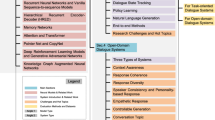Abstract
In this paper we address the task of predicting spaces in interaction where laughter can occur. We introduce the new task of predicting actual laughs in dialogue and address it with various deep learning models, namely recurrent neural network (RNN), convolution neural network (CNN) and combinations of these. We also attempt to evaluate human performance for this task via an Amazon Mechanical Turk (AMT) experiment. The main finding of the present work is that deep learning models outperform untrained humans in this task.
Access this chapter
Tax calculation will be finalised at checkout
Purchases are for personal use only
Similar content being viewed by others
Notes
- 1.
- 2.
In all our experiments we keep 80%/10%/10% training/validation/test split.
- 3.
TypedFlow: https://github.com/GU-CLASP/TypedFlow.
- 4.
Models and data are available at: https://github.com/GU-CLASP/laughter-spaces.
References
Bird S, Loper E (2004) NLTK: the natural language toolkit. In: Proceedings of the ACL 2004 on interactive poster and demonstration sessions. Association for Computational Linguistics, p 31
El Haddad K, Çakmak H, Dupont S, Dutoit T (2017) Amused speech components analysis and classification: towards an amusement arousal level assessment system. Comput Electr Eng 62:588–600
Gilbert CH, Hutto E (2014) Vader: a parsimonious rule-based model for sentiment analysis of social media text. In: 8th international conference on weblogs and social media (ICWSM-14)
Heldner M, Hjalmarsson A, Edlund J (2013) Backchannel relevance spaces. In: Nordic Prosody XI, Tartu, Estonia, 15–17 Aug 2012. Peter Lang Publishing Group, pp 137–146
Howes C, Purver M, McCabe R (2014) Linguistic indicators of severity and progress in online text-based therapy for depression. In: Proceedings of the workshop on computational linguistics and clinical psychology: from linguistic signal to clinical reality, pp 7–16
Jefferson G, Sacks H, Schegloff EA (1987) Notes on laughter in the pursuit of intimacy
Jurafsky D, Shriberg E, Biasca D (1997) Switchboard dialog act corpus. Technical report, International Computer Science Institute, Berkeley, CA
Maraev V, Mazzocconi C, Howes C, Ginzburg J (2018) Integrating laughter into spoken dialogue systems: preliminary analysis and suggested programme. In: Proceedings of the FAIM/ISCA workshop on artificial intelligence for multimodal human robot interaction, pp 9–14
Mazzocconi C, Maraev V, Howes C, Ginzburg J (2018) Analysis of laughables: a preliminary perception study. In: Proceedings of the workshop on dialogue and perception, pp 43–47
Mehu M (2011) Smiling and laughter in naturally occurring dyadic interactions: relationship to conversation, body contacts, and displacement activities. Hum Ethol Bull 26(1):10–28
Meteer MW, Taylor AA, MacIntyre R, Iyer R (1995) Dysfluency annotation stylebook for the switchboard corpus. University of Pennsylvania, Philadelphia
Passonneau RJ, Carpenter B (2014) The benefits of a model of annotation. Trans Assoc Comput Linguist 2:311–326
Poyatos F (1993) Paralanguage: a linguistic and interdisciplinary approach to interactive speech and sounds, vol 92. John Benjamins Publishing, Amsterdam
Sacks H, Schegloff EA, Jefferson G (1978) A simplest systematics for the organization of turn taking for conversation. Studies in the organization of conversational interaction. Elsevier, Amsterdam, pp 7–55
Author information
Authors and Affiliations
Corresponding author
Editor information
Editors and Affiliations
Rights and permissions
Copyright information
© 2021 The Author(s), under exclusive license to Springer Nature Singapore Pte Ltd.
About this chapter
Cite this chapter
Maraev, V., Howes, C., Bernardy, JP. (2021). Predicting Laughter Relevance Spaces in Dialogue. In: Marchi, E., Siniscalchi, S.M., Cumani, S., Salerno, V.M., Li, H. (eds) Increasing Naturalness and Flexibility in Spoken Dialogue Interaction. Lecture Notes in Electrical Engineering, vol 714. Springer, Singapore. https://doi.org/10.1007/978-981-15-9323-9_4
Download citation
DOI: https://doi.org/10.1007/978-981-15-9323-9_4
Published:
Publisher Name: Springer, Singapore
Print ISBN: 978-981-15-9322-2
Online ISBN: 978-981-15-9323-9
eBook Packages: EngineeringEngineering (R0)





